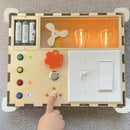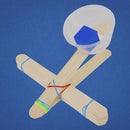Introduction: Simple Pneumatic Machine
This project draws on similar ideas from previous work, but without the use of hot glue. This construction process is very simple, and unlike some of my hydraulic projects, these pneumatic machines operate using only compressed air instead of water.
You can find the lesson plan, 1-page project sheet, and more project ideas at STEM-Inventions.com
Step 1: Materials and Prep
The Engineering Creation Kit has everything you need for this project and many more from STEM Inventions.
Materials:
- 9 craft stick
- 5 jumbo craft stick
- 6 quarter-straw pieces
- 2 eighth-straw pieces
- 1 pipe cleaner
- Plastic syringes, tubing, and adapters
- Or bulk tubing and syringes
- masking tape (Dispenser)
Prep:
- Cut straws into quarters (6 per student)
- Cut straws into eighths (2 per student)
- Cut vinyl tubing into 6" lengths (1 per student)
- Assemble pneumatic systems (recommended for young classes)
Note: The straws are large milkshake straws.
When you make a purchase through these links, I may earn an affiliate commission at zero cost to you.
Step 2: Assemble the Frame
Create 2 triangles using the stick-and-straw building technique.
Click on the 3rd image and look closely at the tape that is used to connect the triangles together. It is folded all the way around the triangle and stuck to itself. This is an important building technique.
Step 3: Create the Hinge
Tape a jumbo stick to the side of the frame that has two craft sticks connecting it together. The jumbo stick can be attached to just one stick if students do not have two sticks on one side (in this situation, tape the front and back of the jumbo stick to the single craft stick.)
Be sure to click on the images to see the building steps clearly.
Use a whole pipe cleaner to connect the sticks. Twist tightly and cut off the excess
Step 4: Add the Pneumatic System
To create a pneumatic system: Fill up one syringe with air, then connect it to the other empty syringe with vinyl tubing.
Tightly wrap one end of the pipe cleaner around the syringe as shown, then tie it to the machine arm.
Attach the syringe to the frame by taping the spot where the tubing connects to the syringe nozzle.
Step 5: Make It Awesome!
This is where students can be most creative. In this example, the machine has: the control syringe taped to a convenient place, extended machine arm, added outriggers for stability, and a pipe cleaner hook.
Other ideas:
- Add a cup on the end of the arm
- Add more outriggers
- Turn the arm into a cork launcher
Step 6: Tips and Troubleshooting
Tips:
- For young classes (grades 1-2) you may want to assemble the pneumatic systems as part of your prep
- Divide this project into 2 parts: Creating the frame, and then create the hinge + attach the pneumatic system. If all of the project steps are presented up front, students will have difficulty remembering them.
Troubleshooting:
- If the machine arm is leaning to one side:
- Tighten the pipe cleaner that connects the hinge
- Tightly wrap tape around the tubing that connects the syringe to the frame
- Tape the syringe to the frame (not too tight)
- If the machine arm is not moving very much:
- Check the pneumatic system for too much or too little air
- The plastic syringe is taped directly to the frame instead of the tubing
- The pipe cleaner that connects the syringe to the machine arm is too tight or not in the right position
- If the machine is falling over:
- The outriggers are:
- Not present
- Taped on poorly
- Not overlapping the frame enough
- Not long enough
- The machine arm is too long or is leaning too muc
- The outriggers are:




